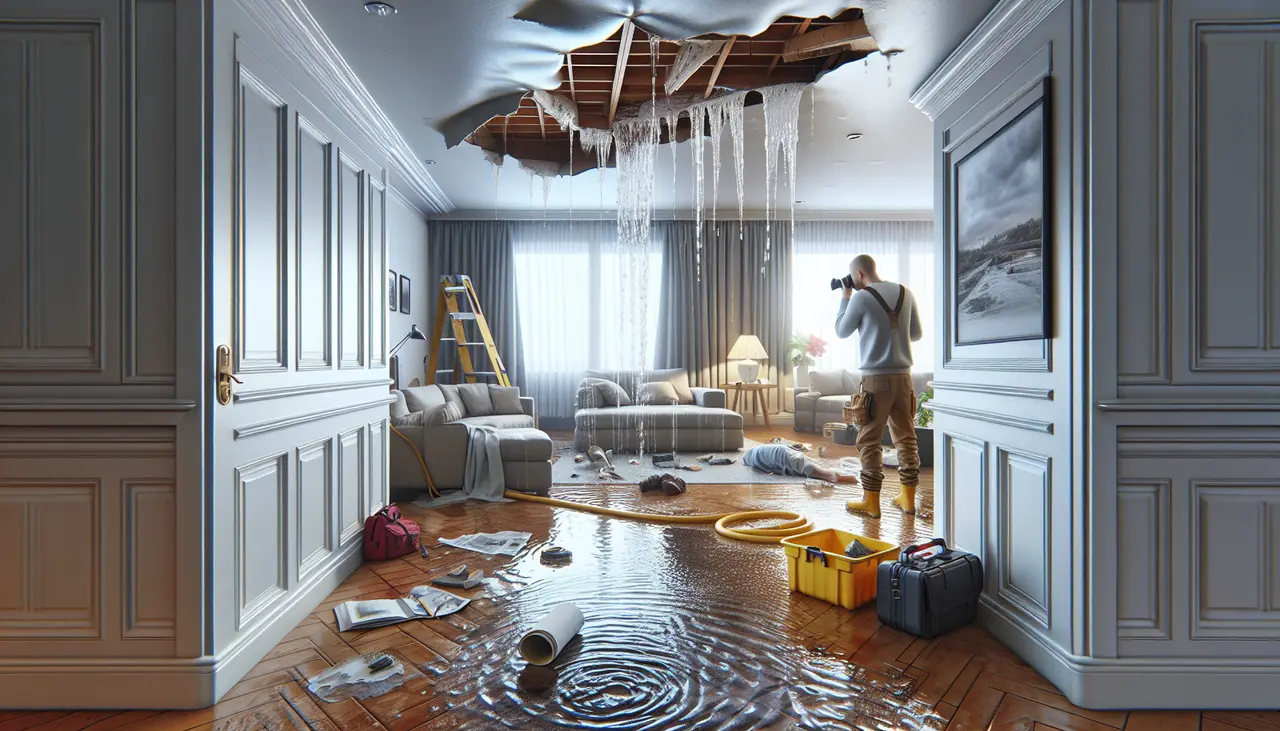Introduction to Ceiling Leaks After a Storm
When a storm hits, it’s not just the rain and wind you have to worry about. After the storm clouds clear, you might find yourself staring at a dreaded ceiling leak. This usually happens when the storm damages your roof or the drainage systems fail to cope with the amount of water, allowing it to sneak into your home. The first sign of trouble could be water spots or drips from the ceiling. At this stage, it’s critical not to ignore these signs. Ceiling leaks can lead to more serious problems like mold, structural damage, and ruined insulation if not addressed quickly. Understanding the potential aftermath of a storm helps you stay on top of the situation, ensuring you’re ready to act fast to minimize damage and prepare for a successful insurance claim. Remember, the key is to act quickly and smartly to protect your home and pocket.

Immediate Actions When You Notice a Ceiling Leak
When you spot a ceiling leak right after a storm, act fast. First, move your stuff. Get electronics, furniture, and anything else moveable away from the leak. This reduces damage and keeps you safe. Next, catch the water. Use buckets, bowls, or any container to catch drips. This simple step can save you from a bigger mess. Then, take photos. Your phone is your friend here. Snap pictures of the leak, water damage, and any related issues. These photos are golden when you file an insurance claim. Lastly, contact a professional. You need someone skilled to assess and fix the damage. Don’t try to fix it yourself; it might make things worse. These quick and straightforward steps can make a big difference in handling ceiling leaks efficiently.
Documenting the Damage for Your Claim
Right after noticing a ceiling leak, grab your camera or smartphone. The first thing you need to do is document the damage. This means taking clear photos or videos of the entire affected area – from the water-stained ceiling to any damaged property below. Don’t just snap a couple of pictures and call it a day. Make sure to capture the damage from various angles and in good lighting. This helps to provide a detailed account of the extent of the damage. Keep a record of the date and time you took these photos. This step is crucial because insurance companies rely heavily on this evidence to assess your claim. Also, jot down notes about what you observe. Did the leak start after the storm? Are there visible signs of mold? These details can support your claim. Remember, your goal is to make it easy for the insurance adjuster to understand the damage and process your claim efficiently.
Understanding Your Homeowners Insurance Policy
Before you start worrying about ceiling leaks after a storm, it’s crucial to get familiar with your homeowners insurance policy. Not all policies are created equal, and not every type of damage is covered. Generally, most policies include coverage for “sudden and accidental” damage. That means if your ceiling starts leaking after a storm, you’re likely covered. However, if the damage is due to neglect or lack of maintenance, your claim might be denied. To avoid surprises, go through your policy. Look for terms like “all-risk” or “named perils.” All-risk policies typically offer broader coverage, including most forms of damage, except those expressly excluded. Named perils policies, on the other hand, only cover risks listed in the document, which might not include every type of storm damage. Knowing what your policy includes and excludes will help you gauge whether filing a claim is worthwhile. If the terminology confuses you, don’t hesitate to call your insurance agent for clarification. Being informed is your first defense against unexpected out-of-pocket expenses.
The Importance of a Professional Inspection
Before you even think about reaching out to your insurance company, getting a professional inspection is key. Why? Well, for starters, a pro can sniff out the damage that isn’t obvious to most of us. They’ll take a good look at your ceiling, but they won’t stop there. They check out the roof, the attic – basically, anywhere water might have sneaked in during the storm. This step is crucial because it sets the foundation for your insurance claim. The professional’s report highlights all the damage, making it hard for your insurance to play the “we didn’t see that” card. Plus, this report can give you a solid estimate of what it’s going to cost to fix everything. Bottom line: Don’t skip the pro inspection. It’s your first big move toward a successful insurance claims
Preparing for the Insurance Adjuster’s Visit
When an insurance adjuster comes to see your ceiling leak, think of it as your time to shine. You want to show them everything, so they understand how bad the storm hit you. First, don’t touch or fix anything before they get there. It’s like the crime scene of the storm, and every detail helps tell your story. Take lots of pictures or videos, from every angle. Make sure these have time and date stamps so your insurance company sees when the damage happened.
Write down a list of all the damaged items and, if you can, what it might cost to fix or replace them. This list is your damage report – keep it clear and to the point. If you have before pictures or bills of the things that got wrecked, have those ready too. It shows what things looked like when they were okay and how much you’ve spent on them.
Be ready to take the adjuster through your house, step by step. Point out every single damage, even the small stuff. Remember, your goal is to make them see the full impact of the storm.
Lastly, ask questions. If you don’t understand something the adjuster says, ask for clarification. This is about your home and your peace of mind, so make sure you’re clear on everything.
Being prepared helps prove your claim and can get you a better chance at covering your losses. So take a deep breath, gather your evidence, and get ready to make your case.
Navigating the Claims Process: What to Expect
First off, breathe. Finding out your ceiling leaks after a storm is stress-inducing, but here’s how you navigate the insurance claims process without headaches. Start by notifying your insurance company right away. Delays can harm your claim. Be ready to provide details about the damage, when it happened, and probably photos or videos as proof. Your insurer will send an adjuster to assess the damage. This person decides how much the company should pay out. It’s smart to have your own list of damages and repairs needed. Compare it with the adjuster’s report. If numbers don’t match, don’t panic. You can negotiate. Remember, insurance policies vary, so knowing what your policy covers before a storm hits is critical. After the adjuster’s visit, your claim will either be approved or denied. If approved, you’ll get funds to repair the leak. If denied, you have the right to ask why and possibly appeal the decision. Throughout this process, keep detailed records of all communications with your insurance company. This includes emails, calls, and in-person talks. Having this info can help if there are disputes. And most importantly, stay patient and persistent. Insurance claims can take time, but following these steps ensures you’re on the right path.
Tips for a Successful Ceiling Leak Insurance Claim
First, act fast and document everything. The moment you notice a leak, start taking pictures of the damage and jot down details about the storm, such as the date and intensity. Get a reliable roofer to inspect and provide a written evaluation of the damage. This documentation is your best ally. Next, review your insurance policy to understand what’s covered. Not all policies are the same, and knowing the specifics of yours is crucial. When making your claim, be detailed and precise. Use the documentation you’ve gathered. Be honest but thorough about the damage and how the storm caused it. Sometimes, insurance companies deploy adjusters to assess the damage. Be prepared to show them everything you have documented. Don’t start repairs until the insurance gives the green light, unless it’s to prevent further damage. If that’s the case, keep all receipts. Clear communication is key. Stay in touch with your insurance provider, and don’t hesitate to ask questions. If your claim is denied, you have the right to ask why and appeal the decision. Remember, persistence pays off in these scenarios.
Conclusion: Avoiding Future Ceiling Leaks
To keep your ceiling dry and your wallet happy, consider these straightforward steps to avoid future leaks. Check your roof regularly, especially after heavy storms. Small issues can turn into big problems if ignored. Clean gutters and downspouts to ensure water flows away from your home, not into it. Trim tree branches that hang over your roof. They can damage shingles or provide a path for water to enter. Finally, improve your attic’s ventilation and insulation. This prevents ice dams in the winter and extends the life of your roof. Taking these actions now can save you from headaches and costly repairs down the road. Stay proactive.

